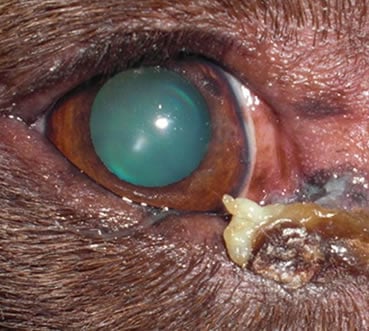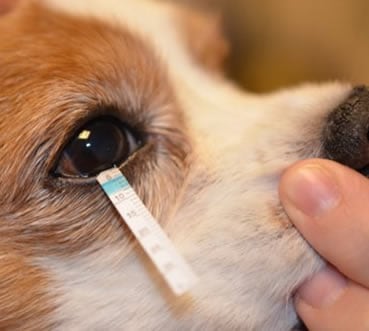From time to time we have all had dry eyes from working too long on the computer or staring at the screen on your cell phone. This will cause dry eyes as you blink less whilst you are concentrating, thus preventing tears from lubricating your eyes. But did you know that there is a medical condition known as ‘Dry Eye’?
Dry Eye is a common condition in Cavalier King Charles Spaniels and is characterized by the lack of tear production which prevents the eyes from being moistened. Decreased tear production causes severe irritation, a burning sensation, debris accumulation, and bacterial overgrowth.
Although this is a terrible condition, which affects not only Cavaliers but most dogs and even humans, all is not lost as it is treatable. The condition cannot be cured, unfortunately, but you can take steps to ease the pain and discomfort it causes.
The Dry Eye Condition
Commonly referred to as dry eye syndrome, the correct name is Keratoconjunctivitis Sicca or KCS. Dry Eye results from a dysfunction of the lacrimal functional unit, which is composed of the lacrimal glands, the ocular surface, and the interconnecting innervations.
Dry Eye isn’t considered life-threatening, but it can lead to scarring, which damages the cornea, and as a result, vision loss.
There are 3 layers that make up the tear film which protects the cornea:
- The Outer Layer – An oily layer to prevent evaporation
- The Middle Layer – An aqueous layer produced by the lacrimal gland
- The Inner Layer – Is in direct contact with the cornea. This ‘mucus’ layer helps the tear film remain attached to the cornea
There are two types of Dry Eye (KCS); Quantitative KCS which begins when there is a decrease or lack of the aqueous layer within the tear film, and Qualitative Tear Deficiency which is a decrease in the mucus layers. Both types result in dryness of the cornea, which can lead to scarring and/or ulceration.
The decrease in tear production fails to clean the eyes correctly which causes bacteria to overgrow, and causes inflammation of the ocular surface. Early signs of Dry Eye could be squinting, or a thick, sticky discharge accumulating in the corner of the eyes.

Common Causes of Dry Eye
There are many causes of Dry Eye, here are just a few:
- Congenital conditions (eg, congenital lacrimal aplasia)
- Infectious diseases (eg, canine distemper virus)
- Metabolic conditions (eg, diabetes mellitus, hyperadrenocorticism, hypothyroidism)
- Temporary or permanent drug toxicity (eg, from sulfasalazine, trimethoprim sulfa)
- Temporary drug side effects (eg, from atropine, general anesthesia)
- Trauma (eg, blunt trauma, radiation treatment)
However, in Cavalier King Charles Spaniels there is another symptom that goes hand in hand with Dry Eye known as ‘Curly Coat’. This is a skin disease that is inherited from the mother and sometimes is accompanied by other developmental defects.
Curly Coat Syndrome is an abnormality of the Cavaliers coat that is seen by breeders at birth and as the Cavalier becomes an adult, there are signs of skin deterioration. It is an extremely uncomfortable condition, and these poor creatures will need a lifetime of daily medicated baths to treat the skin.
Signs of Dry Eye Occurring
There are two distinct signs of Dry Eye, Acute which shows the symptoms of a milder case of dry eye, and Chronic which is when the symptoms are much worse:
ACUTE
- Obvious signs of pain
- Squinting
- Thick, sticky discharge
- Conjunctival hyperemia (an increased blood flow, which causes capillaries to expand and the eye becomes reddened)
- Corneal edema (swelling of the cornea, caused by a buildup of fluid in the cornea. When left untreated, corneal edema can lead to cloudy vision)
- Corneal ulceration (an open sore on the cornea)
- Dense corneal vascularization (Vascularization is the process of growing blood vessels into a tissue to improve oxygen and nutrient supply)
CHRONIC
- Minimal to mild squinting
- Thick, sticky discharge
- Wispy corneal vascularization (Vascularization is the process of growing blood vessels into a tissue to improve oxygen and nutrient supply)
- Corneal fibrosis (develops in response to injury, infection, postsurgical complications, or underlying systemic disease)
- Corneal and conjunctival pigmentation (The conjunctiva (the transparent skin over the white of the eye) sometimes develops brown discoloration.)

Dry Eye doesn’t just exist within the Cavalier King Charles Spaniel breed, there are a few more breeds of dog that are also susceptible to Dry Eye Syndrome, these are:
- Cocker spaniel
- English bulldog
- Pug
- Shih Tzu
- West Highland White Terrier
- Lhasa Apso
Diagnosis
Quantitative Dry Eye is diagnosed with a Schirmer Tear Test (STT). The STT consists of a small strip of specialized paper that has a millimeter scale printed on each strip and each one is impregnated with a blue dye for easy visualization of the results.
Two strips of paper make contact with the cornea, one in each eye, and are left in place for sixty seconds.
The distance traveled by the tears on the test strip in sixty seconds is recorded. The following chart provides an interpretation of the results.
| Measurement | Diagnosis |
|---|---|
| Greater than 15 mm wetting/minute | Normal |
| 10-14 mm wetting/minute | Early Dry Eye |
| 5-10 mm wetting/minute | Moderate Dry Eye |
| Less than 5 mm wetting/minute | Severe Dry Eye |

Treatment
Dry Eye is managed medically, often with a combination of the treatments listed below, however, unmanageable cases may require alternative treatments, such as parotid duct transposition or eyelid surgery.
The parotid duct is a tube that carries saliva from the parotid salivary gland into the mouth. In a parotid duct transposition, this duct is surgically relocated from the mouth into the pocket below the eye – this results in the eye being kept moist with saliva instead of the missing tears.
North Downs Specialist Referrals
Tear Stimulants
One of the most commonly used items to treat Dry Eye are immunomodulating agents (used in treating ocular inflammatory diseases). These reduce glandular inflammation and improve tear secretion. Unfortunately tear-stimulant therapy is not a miracle cure, and is usually a lifelong treatment.
Cholinergic Agents
Neurogenic Dry Eye occurs when the cranial nerve is damaged by trauma, inflammation, cancer, or chronic ear infections. Since this nerve also supplies innervation to the nasal mucosa glands, dogs affected by neurogenic Dry Eye will also have a condition called xeromycteria (a dry nose) on the same side as the affected eye. Most Dry Eye forms attack both eyes, but neurogenic Dry Eye usually affects only one eye.
Cholinergic agents, which trigger tear production, are used to treat neurogenic Dry Eye.
The cholinergic agents used can be administered either topically (directly to the eye) or orally (by adding it to the dog’s food).
Topical administration, however, is often quite irritating. Oral administration is effective but may cause
systemic side effects, such as fatigue or loss of appetite with inappropriate doses, so a small dose should be given first and adjusted slowly to monitor the patient closely for side effects.
Tear Replacements
There are many tear replacement products available to treat tear deficiencies. The choice will be determined by the veterinarians preference, product availability and cost, and the patient’s specific needs determine the treatment required. These medications play a crucial role in Dry Eye management and should be combined with tear-stimulant therapy.
Antibiotics & Anti-Inflammatories
Dogs that suffer from Dry Eye will have problems removing debris from the eyes due to the lack of tear production, and so the bacteria will build up and conjunctivitis can occur. This is a common problem, which can also cause inflammation.
During the early stages of treatment antibiotics can be given to help with the inflammation, with the focus on reducing the frequency of antibiotics being given, and eventually stopping altogether.
Anti-inflammatories or a combination of both anti-inflamatories and antibiotics help reduce the inflammation of the eye, which improves discomfort, vascularization, and the opacity of the cornea.
Sources
For more in-depth knowledge of Dry Eye (KCS), please refer to the sources of my information.


3 thoughts on “Dry Eye in Cavaliers: What is it and How to Treat it”